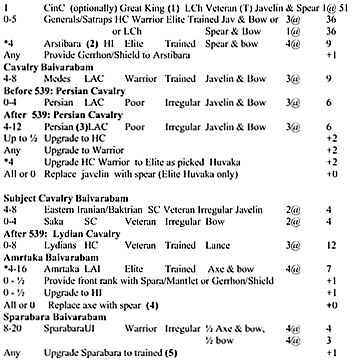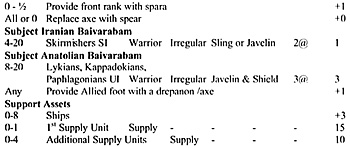It has been estimated that the total population of the Persian Empire circa 490 B.C. was about 50 millions, of which no more than a million were native Persians; this may be compared with a native, mainland Greek population of also approximately a million. As the empire matured, the native Persian component of an Achaemenid army provided the key, core units, but the army, especially at the Empire's apex, was a polyglot admixture of Persians, subject peoples and mercenaries.
At the beginning of their run, however, things were decidedly different. The Persians were rough hillmen who came to be primarily horsemen only after muscling their way to empire. No steppe nomads these, the first Achaemenid army to take center stage was primarily a very successful infantry army whose cavalry arm was provided by Persia's client kingdom, Media; at the beginning of our period, Cyrus the Great, the rising Achaemenid, married into the Median royal family, acceded to the Median throne and brought the kingdoms together.
The first list below establishes a basic ground zero Persian army, including Medes. To this core the Lydian, Babylonian and central Anatolian peoples are added. Significant events in this early period include: ( i.) Cyrus overthrows his Median overlords, 550, (ii.) the fall Babylon, (iii.) the defeat of Lydia, 539 (iv.) the fiat mounting the kinsmen (huvaka), 530's and (v.) the defeat and death of Cyrus at the hands of the Saka, 530 .
In a more technical vein, early Persian infantry tactics were based on defending a fixed defensive perimeter -- the spara wall. Once that wall was breached, the organization of the infantry collapsed . The linear tactics of the Greeks, apparently the only infantry capable of successfully resisting the Persians were, in contrast, based on maintaining forward momentum.
Thus, so long as the Greeks were capable of penetrating the Persian barrier, which could be hacked apart by sword, they held the winning edge. They were apparently well enough protected to bear up under Persian missile fire long enough to break the spara line; this must have been a novel experience for the Persians.
Finally, the best Persian units were a relatively small proportion of the entire army (20/120 stands in the first list, ca. 10,000/60,000). The overall command and control of the entire force was no doubt suspect, and there remains the likelihood that many troops were poorly armed and poorly trained.
There is no way to derive an attested OoB from historical sources, rather what I propose to do is to simplify AW list 47, Early Achaemenid Persian, and add some technical terms -- taken from Nick Sekunda's work - to add pizazz.. The apparent precision of the division into baivarabam is based on reason, not substantive evidence, except for the Amrtaka; the assumptions underlying the list may be made clearer this way.
Army List
120 Stands/60,000


Notes
The Persian king - Great King - was a war leader who was expected to lead his army into battle, but time, distance and political exigencies sometimes mandated that he not do so. Sources indicate the Arstibara were separate from the Amrtaka, There were two hazarabam of Arstibara, one of Huvaka and one of Amrtaka origin, of 1,000 men each. For the scale employed here, these hazarabam represent a total of 4 stands. For the purposes of this list, the 4 stands of the Arstibara are combined with the 16 allowed stands of Armtaka for a total of 20 stands, somewhat lowballing the proportion of the latter allowed in the army.
The Persians were largely infantry until Cyrus instituted reforms in the 530's requiring the 15,000 kinsmen, or Huvaka, to provide themselves horses. It is assumed they weren't very able cavalry, but an elite unit of select cavalry was established at this time. Sekunda notes the reason for this reform was contact with cavalry armies -in Lydia, Baktria and Skythia -- and the possible unreliability of the Medes. Persian cavalry is listed with javelin instead of spear because it was not a capable shock cavalry until later. It is assumed the bulk of the Persian cavalry were drawn from the ranks of the Huvaka; the elite unit certainly was. The traditional weapons of the Persians were the bow and the sagaris. There is evidence that the Amrtaka were all armed with spears, so that option is provided here.
No one knows how well trained these troops were. A good case could be made that they were regulars. This option is more interesting if the special spara rule at the end of the article is used.
More Achaemenid Persians
-
Introduction
A Persian Primer
A Great Power Emerges 550 - 500BC
Attack on the West 500 - 400BC
Civil War 400-338BC
The End 338-329BC
Sparabara House Rule
Back to Saga #81 Table of Contents
Back to Saga List of Issues
Back to MagWeb Master Magazine List
© Copyright 2001 by Terry Gore
This article appears in MagWeb (Magazine Web) on the Internet World Wide Web. Other military history articles and gaming articles are available at http://www.magweb.com